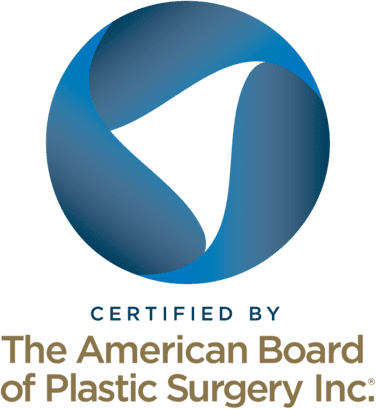Top Surgery Before and After: A Comprehensive Guide
Medically reviewed by Jennifer Richman on November 22, 2024.
A common request from patients considering top surgery are before and after images. Viewing these gives prospective patients an idea of what their results may look like. Increased visibility of top surgery results allows for transgender and non-binary people to see a future for themselves. Likewise, before and after pictures can give patients an idea of how their results will change as healing progresses. In this guide, we include information on the top surgery process as well as imagery of the before and after of top surgery informed by our patients at GCC.
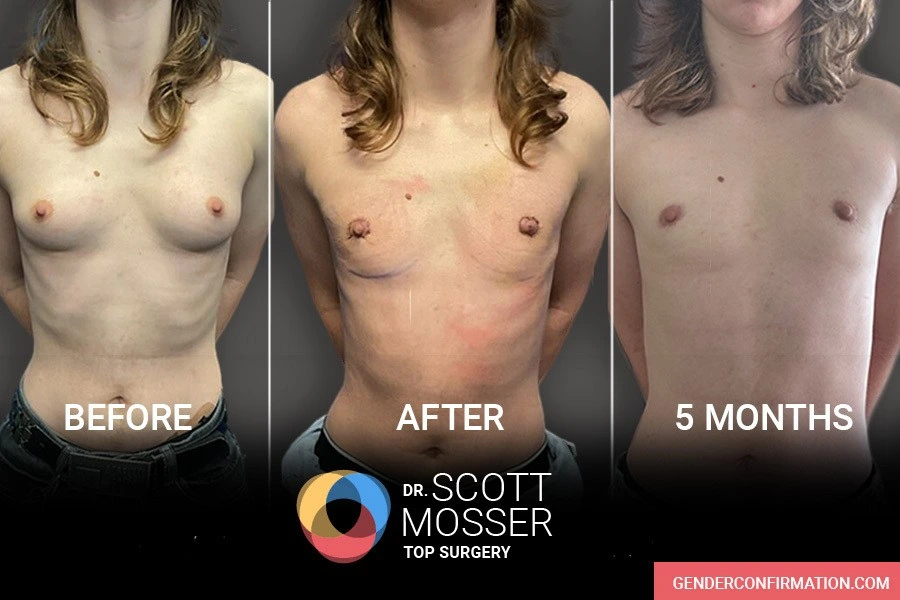
The above before & after photo set shows the results of a periareolar procedure.
What is Top Surgery?
Top surgery is a broad category of gender-affirming procedures intended to give a patient a greater sense of congruence between the appearance of their chest and their gender identity. What often gets called “FTM top surgery” and non-binary top surgery are chest reconstruction and breast reduction techniques.
Top surgery procedures that leave patients with a flat chest include double incision, periareolar and keyhole. Techniques that remove partial tissue such as buttonhole and inverted T anchor are also requested by patients, oftentimes because they want some left over volume on their chest.
Top surgery is also sought out by transfeminine and nonbinary patients to increase chest volume. These procedures include breast augmentation and can sometimes be called “MTF top surgery”. Most of this article will cover chest reconstruction and breast reduction top surgery. For more information on breast augmentation, click here.
We tend to not use “FTM” or “MTF” surgery, as this can imply that gender-affirming surgery is what makes someone a man or woman. This not only ignores the unique goals of nonbinary patients that pursue top surgery, but also denies the reality that trans people are the gender we identify as. Surgery nearly affirms our identity, it does not make us a certain gender.
Before Top Surgery: Preparing for the Procedure
Consultation
The first step in the top surgery journey is to schedule an initial consultation with a surgeon. Our consultations at the Gender Confirmation Center (GCC) are free of charge and can be scheduled virtually (most often as phone calls) or in person. We recommend coming to your consultation with an understanding of what you would like top surgery to give you in terms of aesthetics, sensitivity and function. Some common considerations include how you want your nipples to look and feel, flatness of chest and scar appearance. Coming informed into a consultation allows for better communication of your vision with your surgeon.
Preoperative Considerations
There are several considerations to take into account before top surgery. While hormone replacement therapy (HRT) is not a requirement for top surgery, many account for changes from HRT before surgery. For example, testosterone may shift fat in the body or breast tissue size. Others engage in chest exercises pre-op to create a more pronounced contour along the pectoral muscles. Note that there are no BMI limitations at GCC for top surgery.
Lifestyle Changes
To ensure proper healing and lower your risk for complications, it is best to quit smoking and alcohol at least three weeks before surgery. You should also disclose any medications or supplements you may be taking as they may interfere with anesthesia and pain medications.
Insurance and Financial Considerations
The out of pocket cost for top surgery at GCC is $8,500 to $11,500. Patients can cover the cost of their surgery with insurance. Our insurance advocacy team has a 90% success rate in securing coverage for interested patients with insurance. You can view our list of accepted insurances, but viewing your individual plan will give you the best understanding of what requirements you may need for surgery. If the GCC is out of network, you may need a referral letter from a primary care provider or a support letter from a mental health provider. For questions, you can contact insurance@genderconfirmation.com.
During Top Surgery: What to Expect
The Surgical Process
Your specific procedure will vary depending on technique. In general, you will be put under anesthesia for the procedure. An incision will be made on the chest, which will be used to remove breast tissue or insert breast implants. Where this incision is made depends on the specific top surgery technique used. In double incision, buttonhole and inverted T anchor, two incisions are made along the chest wall and skin is peeled back for breast tissue removal. For periareolar and keyhole, incisions are made along the areola. If you opt for nipple grafts, then your nipples will be removed, resized and repositioned on the chest. Skin is scraped off to expose nerves, and your nipple grafts will be placed on this area. They will then be covered by nipple boilsters to facilitate healing and allow for blood vessels to grow into the grafted skin. Afterwards, your incisions will be closed and your chest will be wrapped in bandages. You can expect to return from the hospital after your surgery is finished, but you will need someone to drive you home. You will not be able to drive yourself home after the surgery.
Potential Risks and Complications
With any surgery, you can expect some complications and potential risks. At the GCC, we have a very low rate of patients that experience nipple graft rejection or failure. Likewise, to reduce the risk of seromas or hematomas, certain patients will be sent home with drains to prevent fluid build up.
Ceasing smoking twenty one days before surgery and avoiding marijuana edibles 24 hours before will reduce the chance of complications. Doing so mitigates complications with anesthesia, pain medications and healing. We encourage you to review supplements and medications to avoid before surgery and disclose this information to your surgeon. Communicating with your provider is vital for avoiding possible complications.
After Top Surgery: Recovery and Care
Post-Operative Care Instructions
Your surgeon should provide you with post-operative instructions on wound care, managing drains and pain medication. These will help with addressing post-op swelling and discomfort, which is very normal in the first week of recovery. If you receive nipple grafts, you will also need specific instructions on caring for them. Depending on your surgeon’s instructions, you may need to redress your wounds and monitor your incisions. Do not remove dressings, drains or take a shower until you are cleared by your surgeon to do so.
Follow-Up Appointments
Your provider will need to schedule a follow up appointment approximately a week after surgery. This is an important step in your recovery, as it will allow for your surgeon to monitor your progress and address any complications. If healing is going well, your surgeon may remove your drains, dressings and clear you for showering in a limited capacity.
Emotional and Physical Support
Surgery is an intense process, and you will not only need a strong support network to help you manage basic physical tasks, but also an emotional support network. You may feel a mix of emotions during recovery, from joy at your new body to feelings of depression. It can be helpful to reach out to loved ones, mental health support and community resources. You can read our guide on emotional and physical reactions to surgery here.
Returning to Daily Activities
You can return to work or school after about two to three weeks if you are healing well. You will still have restrictions on physical exertion and heavy lifting. If your job involves intensive physical activity, you may want to wait about three to six weeks before returning to work. After three weeks, you can slowly build up to more heavy exercise. You should still avoid lifting anything above 25 lbs or weight bearing exercise. At six weeks you should be able to engage in normal activities and exercise.
Showering is possible after your first follow-up appointment, but you should avoid submerging your chest in water for three weeks. In the first three weeks, you can slowly return to light exercise, such as light walking. For more information, you can view our general recovery timeline.
Top Surgery Before and After Photos
Top surgery before and after imagery is a helpful tool in not only increasing visibility of trans and non-binary bodies, but also for understanding how your own surgical results may look. Having a diversity of body types, techniques and skintones is useful for patients in setting aesthetic goals for their procedure. Viewing the scarring associated with each technique, and how results look over time can be important in making your personal choice in what method you will want to explore.
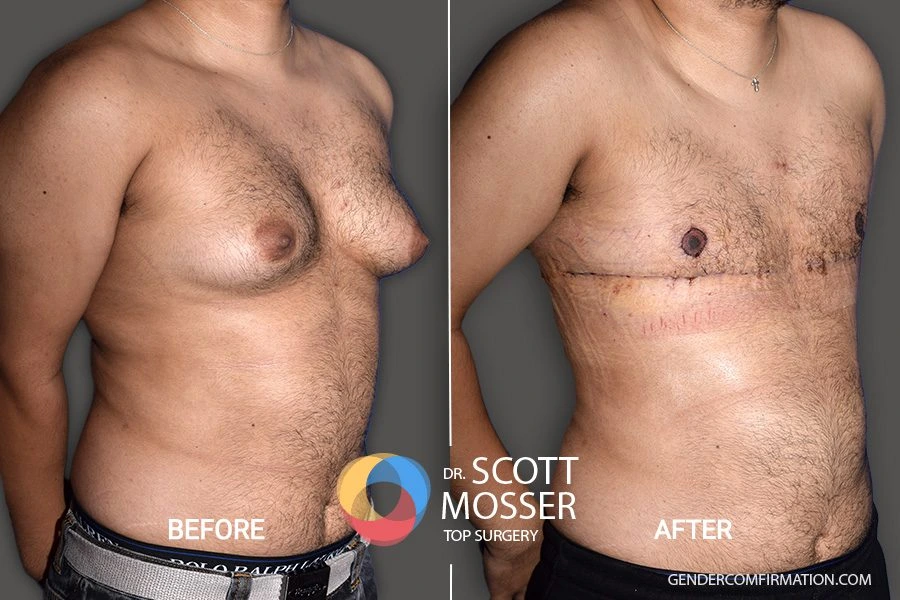
This is a double incision with free nipple grafts. Double incision allows for the surgeon to remove large amounts of tissue and have greater control over the chest shape. Free nipple grafts allow for nipples to be placed in a new position, resized and reshaped to match patients’ aesthetic goals.
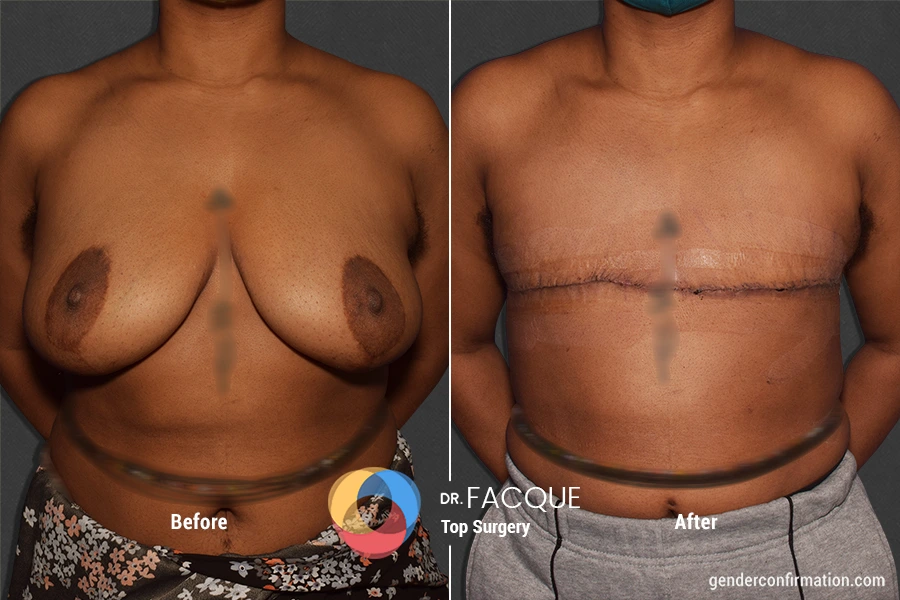
This is a double incision top surgery without nipple grafts. Patients may sometimes receive nipples from medical tattooing, but others prefer the aesthetic of no nipples.
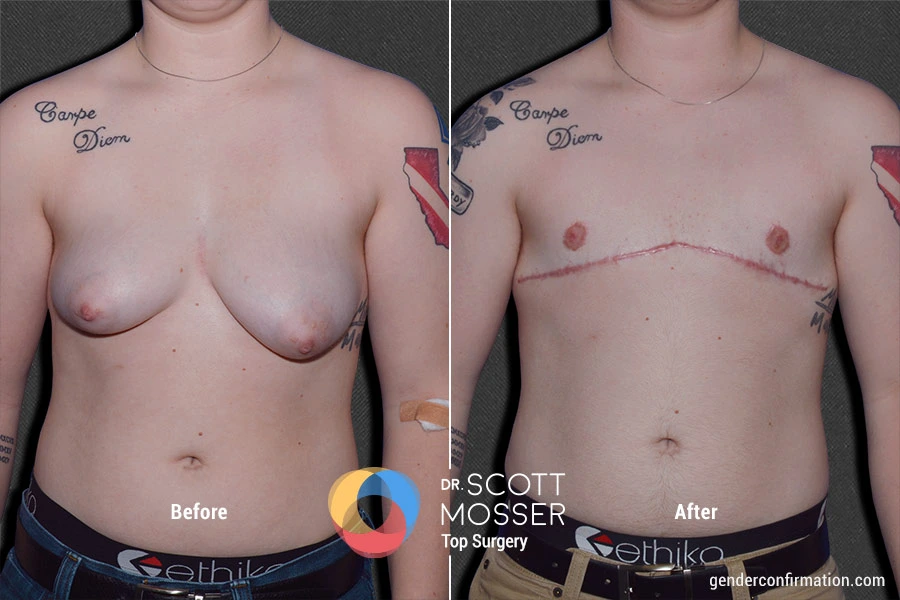
This is a double incision surgery with free nipple grafts where the incision is joined in the center of the chest. This is performed to reduce excess skin in the chest or dog ears. You can discuss whether you may need your incisions to join with your surgeon.

This is another double incision surgery with free nipple grafts. The patient chose to have the nipples placed farther apart. The scar is also raised above the pectoral muscles. You can alter scar placement to a certain degree based on your personal preference. There are many options available for alternate nipple and scare placements.
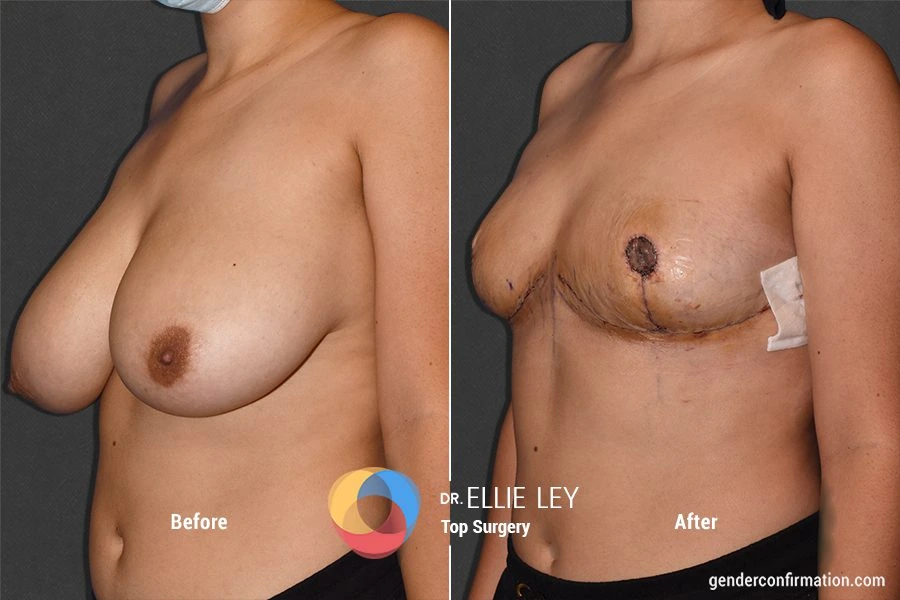
The above technique is the inverted T incision. This preserves some chest tissue and changes the “teardrop” shape of the chest into a more “moundlike” shape. This can alleviate dysphoria from a large, teardrop shaped chest, but also allows for flexibility in gender presentation. Sensitivity is preserved in the nipples, as they stay connected to the original nerve supply.
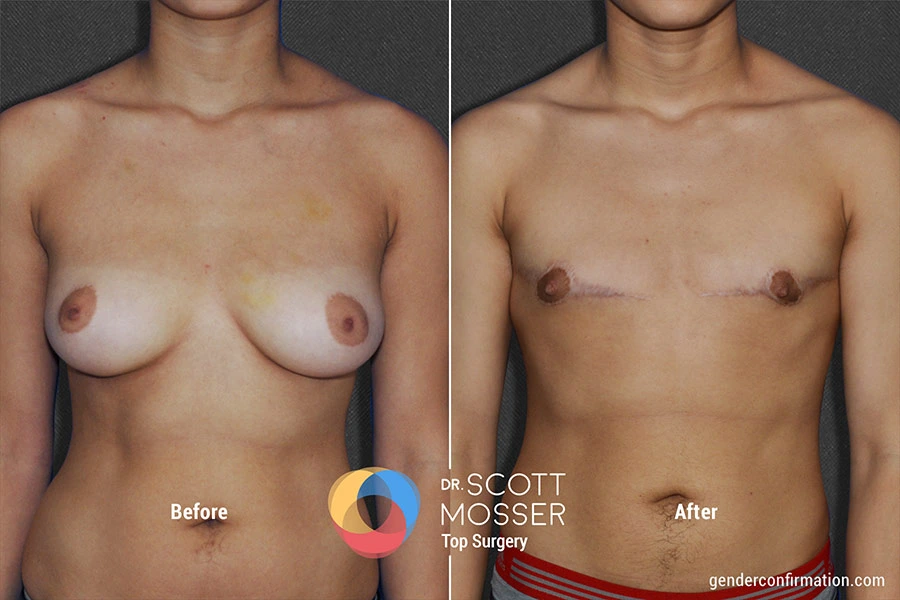
The above is the fishmouth incision technique, which is a more uncommon procedure. Two incisions are placed in the middle of the chest across the nipples. A notable advantage with this technique is the preservation of nipple sensitivity along with reshaping and resizing of the nipple.
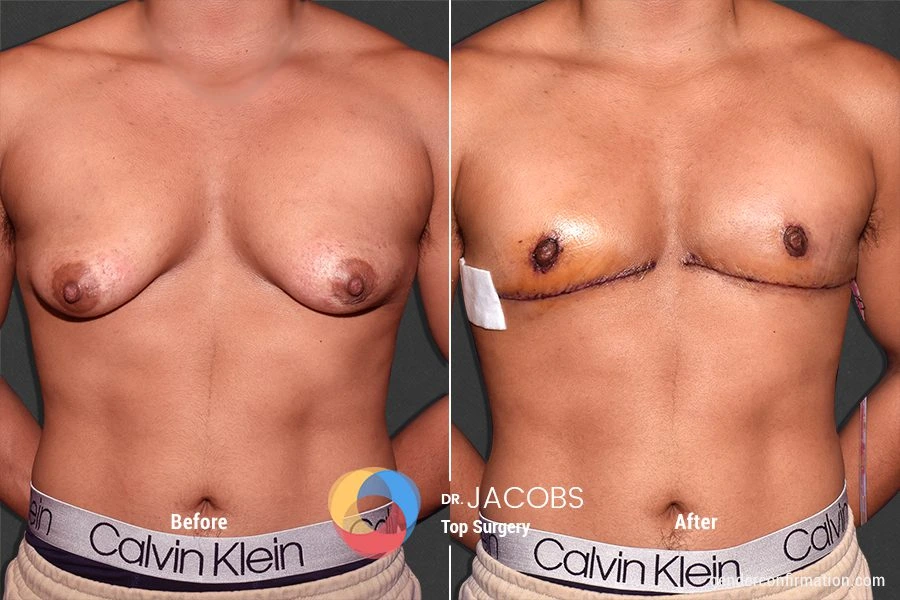
This technique is the buttonhole incision. This method preserves some chest volume and sensitivity in the nipple. Some choose this method to have gender presentation fluidity. Others choose this buttonhole to “masculinize” their chest as the volume can appear as pronounced pectoral muscles.
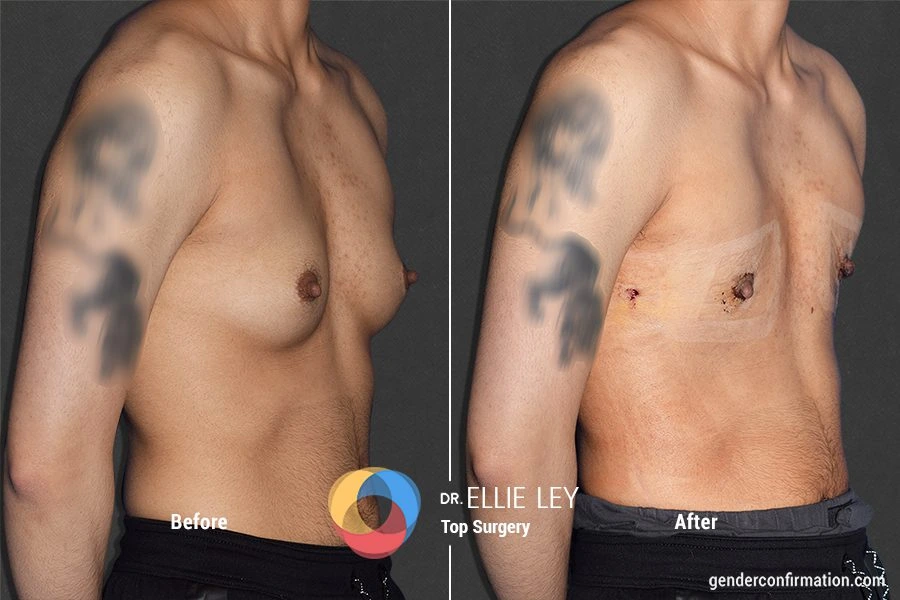
This is the periareolar technique with some nipple projection maintained. The patient chose to keep nipple projection, while reducing the size of the areola. This may be chosen as some surgery can flatten the nipple, or in order to be able to feel a “3-dimensional” nipple. Periareolar allows for retention of nipple sensitivity, but also creates a flattened chest with reshaped nipples.

This is an example of breast augmentation (alternatively referred to as “MTF top surgery”).This is often chosen by patients to add more volume and fullness to the breasts or alter the overall breast shape with the use of implants.
For more, you can explore our before and after image gallery.
Request a Free Surgical Consultation Today.
All virtual and in-person consultations with our board-certified surgeons are free. Once you fill out this form, our patient care team will reach out and guide you through every step to get to surgery.


